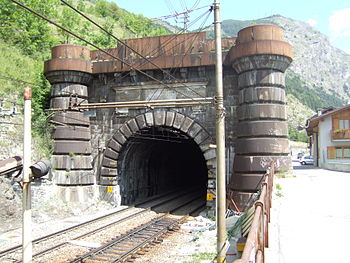- Fréjus Rail Tunnel
-
The Fréjus Rail Tunnel (also called Mont Cenis Tunnel) is a rail tunnel of 13.7 km (8.5 mi) length in the European Alps, carrying the Turin–Modane railway through Mount Cenis to an end on connection with the Culoz–Modane railway and linking Modane, France and Bardonecchia, Italy. It passes beneath the Pointe du Fréjus (2932 m) and the Col de Fréjus (2542 m).
The initial gallery was 12.8 kilometres long, twice as much as the previously longest tunnel. Drilling started in August 1857 from Bardonecchia and in December 1857 from Modane. On 26 December 1870, French and Italian workers shook hands as both teams met halfway: the galleries were aligned to about 40 cm horizontally and 60 cm vertically. The tunnel opened for traffic on 17 September 1871, thus making it the oldest of the large tunnels through the Alps. The gallery was extended to its present length in 1881 with a new reinforced entrance on the French side.
The construction, directed by Germain Sommeiller, was scheduled to take 25 years, but was completed in only 14 years thanks to technical innovations such as pneumatic drilling machines and electrical ignition of explosive charges. In the final construction years, the use of recently-invented dynamite further accelerated the tunnel's completion. The next two Alpine tunnels were built with similar techniques: the Gotthard Rail Tunnel opened in 1882 and the Simplon Tunnel in 1906.
The Fréjus tunnel remains today as an important link in the connection between Rome and Paris, via Turin and Chambéry. Following the development of car and truck transportation, the Fréjus Road Tunnel was built along the same path from 1974 to 1980. A future high-speed rail tunnel to improve transit capacity between France and Italy is being planned as part of the Lyon Turin Ferroviaire initiative.
Contents
Mont Cenis Pass Railway
Main article: Mont Cenis Pass RailwayFrom 1868 to 1871 the Mont Cenis Pass Railway worked as a temporary link over the Mont Cenis Pass. It was closed soon after the Fréjus railway opened.
Fortifications
The Fréjus Tunnel was seen as a possible invasion route from Italy to France, avoiding the difficulties of the Mont Cenis pass. Accordingly, an extraordinary amount of fortification was placed around Modane. The Fort du Replaton and the Fort du Sapey were built in the late 19th century on the heights across the valley of the Arc. In the 1930s the Maginot Line fortifications Ouvrage Saint-Gobain, Ouvrage Saint-Antoine and additional fortifications at Le Sappey were built.[1]
A blockhouse along the rail line to the east of the modern tunnel entrance has become a tourist attraction. The maison penchée ("leaning house") was built in 1939 to guard the tunnel entrance over an ammunition magazine connected to the tunnel by a gallery. In 1944 the retreating Germans exploded two rail wagons inside the tunnel entrance, causing the magazine to explode and blasting the blockhouse off its foundations, landing on a tilt.[2]
Monumental entry
The original monumental entry on the French side of the tunnel at Modane is now a tourist attraction, having been bypassed in 1881 in favor of a new entrance somewhat to the east in more stable ground. A steam locomotive has been placed in the entrance, which is now located along a roadside.[2]
See also
References
- ^ Puelinckx, Jean; Aublet, Jean-Louis & Mainguin, Sylvie (2010). "Replaton (fort du)" (in French). Index de la fortification francaise 1874-1914. fortiff.be. http://www.fortiff.be/maginot/index.php?p=2709. Retrieved 10 February 2010.
- ^ a b "Monuments" (in French). Mairie de Modane. http://www.modane-valfrejus.com/www-liste_monuments-37-FR-decouverte_et_tourisme.html. Retrieved 11 February 2010.
Preceded by
Standedge Tunnel1871–1882
Fréjus Rail TunnelSuperseded by
Gotthard Rail Tunnel
Wikimedia Foundation. 2010.

